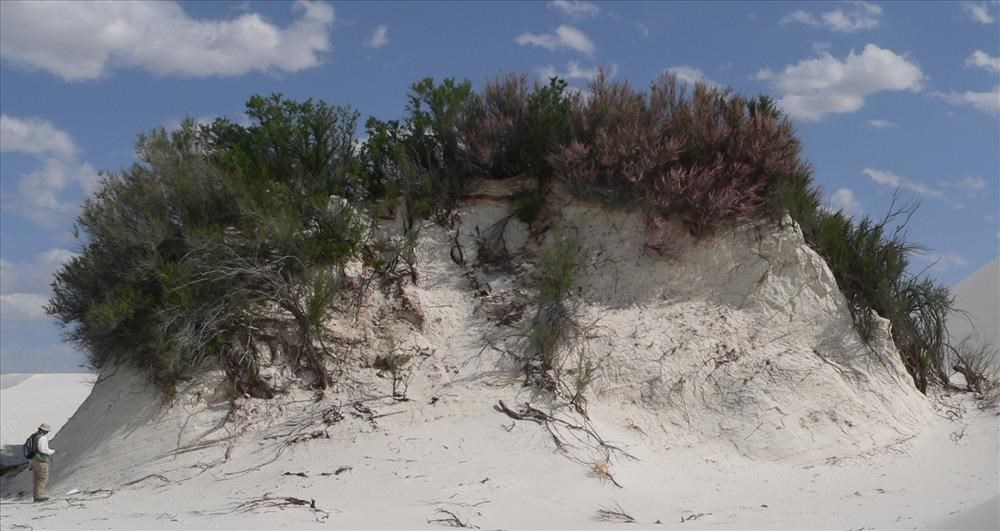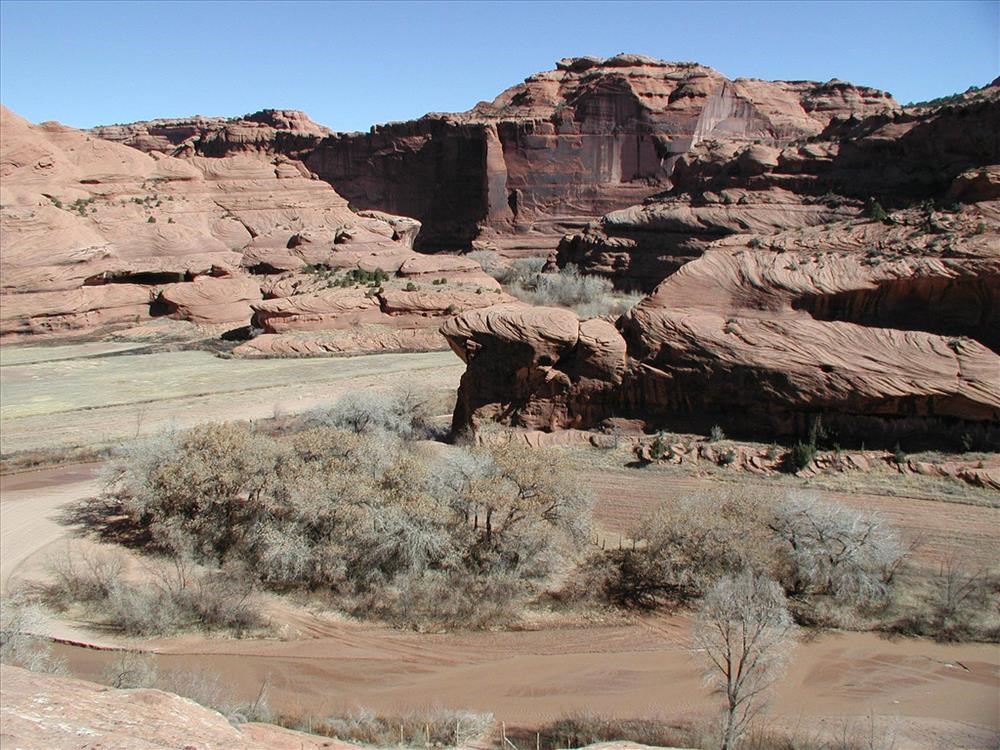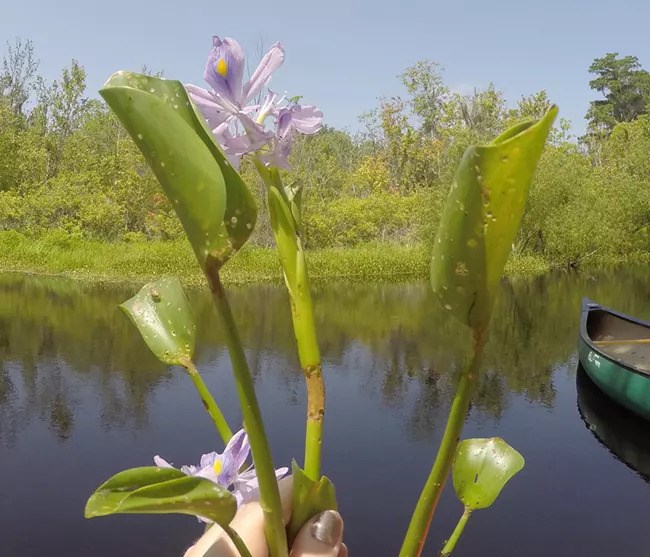Last updated: December 2, 2024
Article
Restoring Balance: The Battle Against Invasive Riparian Plant Species

NPS / David Bustos
We’re incredibly fortunate to have some of the most beautiful mountain, river, and grassland landscapes across the United States but their resilience – a key characteristic of national parklands – is threatened by invasive species. National Park Service (NPS) park managers, restoration biologists, and other partners are at work to control invasive species through multiple projects in parks of the American southwest. These projects are possible because of funding from the Inflation Reduction Act (IRA).
Understanding the Threat
Invasive species are non-native organisms that spread rapidly and cause harm to national parks and can even outcompete native species.
“Invasive species spread rapidly for a number of reasons, most notably because they can tolerate a wide variety of habitat conditions and disturbances,” said Katie Vinzant, a restoration biologist with the NPS. “They produce a lot of viable seed and can sometimes produce multiple generations in a single growing season.”
Invasive species have another advantage: no local predators to keep them in check.
“That allows them to spread rapidly and outcompete native species,” said Vinzant.
Invasive plants are wreaking havoc in parks in Arizona, New Mexico, Texas, Colorado, and Utah—and have become a significant concern for the NPS. It’s essential to understand these invasives at an individual park level so that everyone can understand the true dangers these invaders create at a large scale.
The ‘Riparian Area Restoration Project’ spans across 13 total parks that received IRA funding in 2023, working with partners and the NPS Invasive Plant Management Teams (IPMT) to both eradicate invasives and restore native vegetation.
“Understanding the impact of invasive species, especially in these water-rich, riparian ecosystems, is crucial. They alter habitats, reduce food resources for native wildlife, and can lead to long-term ecological damage,” said Vinzant. “From park to park, we almost always remove invasives and plant native species. It’s the best response we have today.”

NPS Photo
Lessons from the Field
Bandelier National Monument Natural Resource Program Manager Sarah Milligan leads this IRA project. She has been instrumental in the success of these large-scale ecosystem restoration projects. Milligan, working in unison with restoration biologists like Vinzant, is on the forefront of the development and implementation of proposals for landscape-level restoration projects.

NPS / NASA DEVELOP (Bandelier Ecological Conservation Team)
“Over the years, we’ve learned what works and what doesn’t,” Vinzant said. “Manual removal of invasive shrub species, such as tamarisk and Canada thistle, is possible and necessary, but often end up only spreading invasives more broadly across an ecosystem. A combination of manual labor and spraying with herbicide is absolutely necessary to actually control and eradicate most shrub species – whether it’s thistle, tamarisk, or Siberian Elms in Bandelier.”
This combination described is an effective methodology used by IPMTs across the scope of this project. The application process is called direct foliar application. Direct foliar application goes directly on the stumps or roots of these invasives, eventually allowing water the chance to come back in those riparian ecosystems, and therefore giving existing natives a healthy, non-invasive infested environment, to repopulate.
Milligan and Vinzant’s experience underscore the importance of tailored management strategies for hands-on projects such as this. Each park presents unique challenges, requiring specific approaches to effectively manage invasive species; for instance, in Bandelier National Monument, efforts are focused on removing Siberian elm and Russian olive trees, while other parks like Wupatki National Monument, San Antonio Missions National Historical Park, and Rainbow Bridge National Monument deal with camelthorn, aquatic invasives like water hyacinth, bamboo, and elephant ear, and Russian thistle and tamarisk, respectively.

NPS / Liz Marchio
Collaborative Efforts and Challenges
Collaboration is also key to these efforts. Conservation youth crews, including the Southwest Conservation Corps and Ancestral Lands Conservation Corps, are set to assist with invasive species removal work at Bandelier National Monument starting this fall. This partnership highlights the critical role of external organizations in achieving restoration goals.
“A lot of these parks are utilizing youth agreements with Ancestral Conservation Lands Corps, friends groups, or other groups like that,” Milligan said. “Bandelier, for instance, put money in for Ancestral Lands for three years. The National Park Service benefits directly from our partnership with Ancestral Lands (Conservation Legacy) by engaging underrepresented Indigenous youth in projects that reconnect them to the land and their heritage while at the same time preserves the natural and cultural resources of the Parks.”
This relationship creates career training opportunities for youth in natural resource management and also enhances the parks’ capacity to complete projects that otherwise cannot be accomplished given current staffing levels.
Another member of the multifaceted team that is tackling this project, John Mack, biological resource program manager, emphasizes the urgency behind invasive restoration projects.
“Climate change is accelerating the spread of invasive species. We need to act swiftly, but we also must respect Tribal lands and those relationships. We’re working in a large variety of different parks, but if there are any consistencies from park-to-park, there are three key invasive shrub and tree species—Siberian Elms, Tamarisk, and Russian Olives—that suck up a lot of water in drier riparian areas,” Mack said.
Generally, the path to treating these invasives is going in with “hand crews” that manually cutting down these trees and shrubs, and then treating with herbicides – but the path forward from there can differ from park to park. Sometimes, park crews will stop after treating with herbicides, allowing for existing natives to repopulate, but in other instances, willows and other fast growing native plant species will be used to repopulate and increase resiliency chances for native species.
“The specifics amongst parks – how they’re treating invasives and restoring ecosystems, essentially – are tricky. You might ask, ‘So – What are you doing? Who are you doing it with?’, which are good questions,” Mack said. “We’re allowing parks the flexibility to go with agreements—sometimes with Tribal partners, sometimes with conservation crews, and then sometimes, because of the nature of the park and the area that needs to be treated, it’s more effective and efficient to use our already existing invasive plant management teams that will either go out and/or train park folks on what needs to be done, when, and why.”
The Road Ahead
The NPS's battle against invasive species is a long-term commitment, demanding continuous effort and adaptation. As funding fluctuates and new challenges emerge, program managers and restoration biologists like Mack, Vinzant, and Milligan agree adaptive management and ongoing learning is the top priority. The IRA provides a crucial boost, but the work on the ground—manual removal, replanting natives, and monitoring—requires persistence and resilience.
“We’re excited about the potential of these projects,” said Milligan. “With the right support and strategies, we can restore these ecosystems and preserve the natural heritage of our parks for future generations.”
Learn More:

Ben is a current graduate student at Colorado State University, within the Journalism & Media Communication Masters of Science Program. He works as a BIL & IRA Science Communication Specialist with the National Park Service's Natural Resources Office of Communications. Apart from his work, Ben is a professional triathlete, with an affinity for adventures and exploration in the mountains.
Tags
- bandelier national monument
- canyon de chelly national monument
- canyonlands national park
- great sand dunes national park & preserve
- hovenweep national monument
- lake meredith national recreation area
- pecos national historical park
- rainbow bridge national monument
- san antonio missions national historical park
- tonto national monument
- tumacácori national historical park
- white sands national park
- wupatki national monument
- inflation reduction act
- science
- ecosystem restoration
- invasive species
- natural resource management
- plants
- invasive plants
- invasive plant management teams
- #jmrlc
- jmrlc
- climate resilience
- managing invasive species
- bipartisan infrastructure law
- ecosystem
